The killing of Nahel Merzouk was not an accident. The 17-year-old French Algerian boy was killed where the potential for conflict is high, in Nanterre. A young Muslim in a yellow Mercedes along the western Champs-Élysées unfortunately made Nahel a prime candidate for police violence resulting in death. His death brought about a week of conflict between low-income residents of Parisian suburbs and the French police. The killing is set in the context of centuries of conflict among the native French population, declining due to low birth rates, and Northern African Muslim population, rising to find jobs and escape war. To counteract this inversion of power in numbers, the executive power of the police has been enforced through policy change and the freedoms of Muslims to practice Islam have been degraded by the unequal enforcement of secularism and the promotion of a “French” Islam. The French state projects the ideals of liberty, equality and fraternity but France is not liberal in its policy, not equal in its application of power, and is not a brotherhood.
Through the lens of the murder of Nahel Merzouk by French police, the experience of conflict is mapped as a field charged by differences in freedom and power along lines of movement, the metro system, in the Parisian province of Ile-de-France. Instances of police violence resulting in death are correlated with the demographic conditions of municipalities and their neighbors. The conflict is contextualized by both historic violence against Northern African Muslims and recent grabs for political power to understand where executive power is exercised and legislative power may be structured.

French justification of ideals avoids the reality of structured power that governs place-based opportunity in Greater Paris. Nahel is an exemplar victim of the unjust exercise of power and the resulting widespread expression of political violence by disenfranchised counterparts is the grand scope of frustration in the fringe.
The reality is that Nahel neither Nahel nor the French republic are unique actors in the conflict between Western ideals and Islam in practice. The population of Muslims in many European countries is rising. Islamic extremism is a source of fear that pushes police to hastily to react to threats. For nations to prepare for the inevitably collision of state ideals with Islamic practice, they may learn from the failures of the French to protect, value, and integrate their Muslim population.
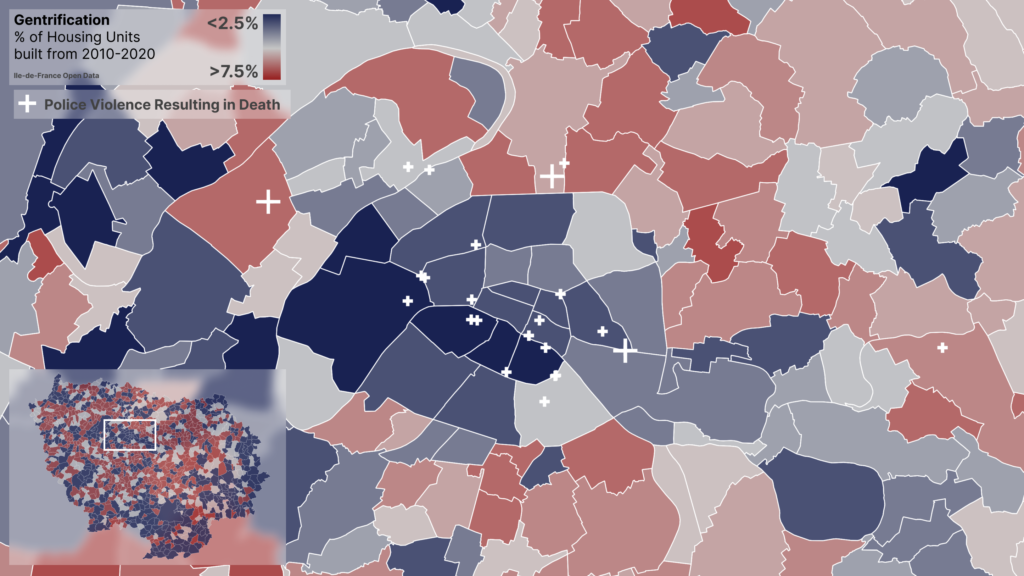
The French political system, income inequality, and restrictive secular policy are lasting institutions but policy change can push French ideals closer to reality. Where new replaces existing housing, the sites of gentrification, this change is needed most. Anti-displacement strategies may support greater equality in infrastructure, repeals to enforcements of police power may reduce bias in the exercise of executive power, and a more even, common rhetoric may promote a better brotherhood.
The Conflict Experience
Conflict, measured as recent instances of police violence resulting in death, is mapped to correlate instances with a series of potentials, charged demographic conditions of static space, and networks, connections among differential static spaces to understand how and where power is structured.
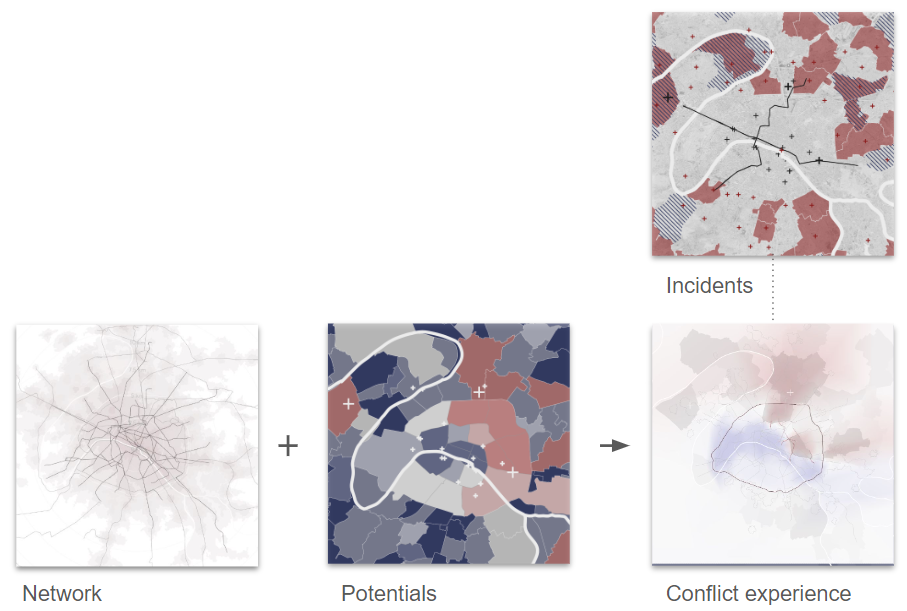
The conflict is understood through the following context:
- The powers of the police were bolstered through 2017 and 2020 policy changes.
- Police violence and global terrorism are on the rise and Paris has frequently been a site of conflict, increasing tension between the Paris center and fringe.
- The reaction to police violence is furious and widespread because people are angry: not just Muslim people who have had their freedoms taken by recent policy changes but also low-income people as seen through the Yellow Vest Movement, who are frustrated by lack of decent job opportunities.

The Instance in Question
Nahel vs. The Police | On the morning of the 27th of June Nahel Merzouk, a Parisian teenager of Algerian descent, was fatally shot by police shortly after he was stopped for speeding. The event sparked violent riots which spread from the site of the murder in Nanterre, through the Parisian suburbs, banlieues, and thereafter throughout France. The killing of Nahel and the subsequent riots are an expression of a long-lasting conflict between the central power of France, represented by the police in practice and Macron in discourse, and disenfranchised groups, represented by the low-income youth that took to the streets.

A Week of Conflict | An initial mapping of police violence in Paris (2019-2023) and the riots in the week following Nahel’s death revealed that there was a clear division in the nature of the violence. While police violence is more common in the central parts of Paris, the instances police violence resulting in death occur just outside the city center. This is also where the riots took place, reacting against both the police violence and a lack of opportunity. The reaction to police violence is violent where a high percentage of the housing stock is new. Areas with greater than 10% of housing built between 2010 and 2020 saw the most property damage.
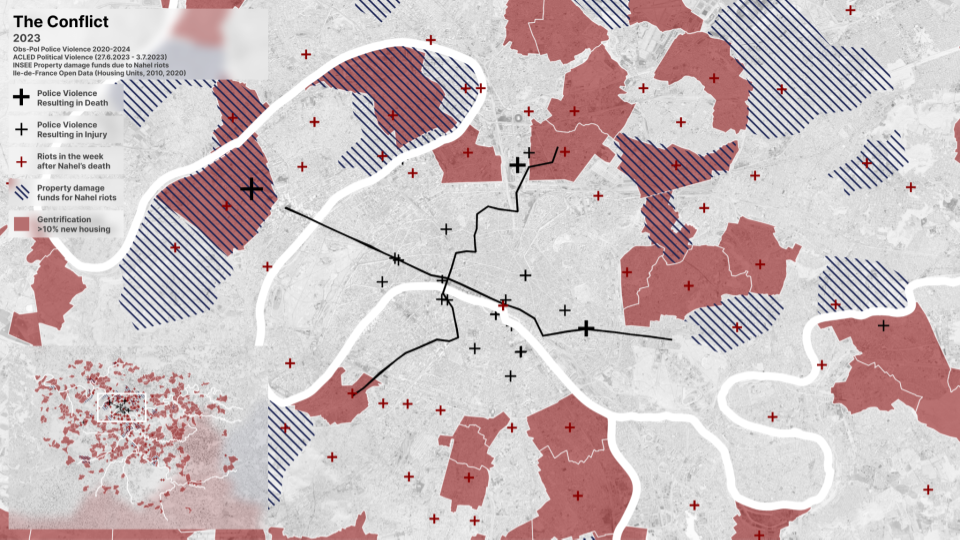
Ideals
Liberté, Égalité, Fraternité | French constitutional ideals of liberty, the freedom to be, equality, to be equal, and fraternity, to be a collective have been squashed by processes and policies that ensure structured power remains in the Parisian center and the land occupied by disenfranchised groups is available for conquest. French secularism has allowed the government to evade measured impact of inequality by demography. France’s largest significant non-White population, Northern-African Muslims, have suffered from the evasion of these ideals. Nahel’s Northern-African heritage seemed to channel the the frustrations churned from the evasion of responsibility of the historic ethnic conflict that diametrically opposes ideals.
Centuries of Conflict | The week of conflict was set in the context of centuries of conflict between the French and their Northern African counterparts who have engaged in violence through periods of colonization, independence, targeted terrorism, and globalized terrorism. The heart of the conflict is over liberty and ownership of property. The conflict materializes as deaths followed by riots. Still, over 70% of migrants to France from Muslim-dominant countries come from just three nations: Algeria, Tunisia, and Morocco. As France does not track data on race, the population of this demographic in Paris is unknown. Without an understanding of where population is concentrated, the impact of state and private investment on any specific race’s space is impossible to implicate.
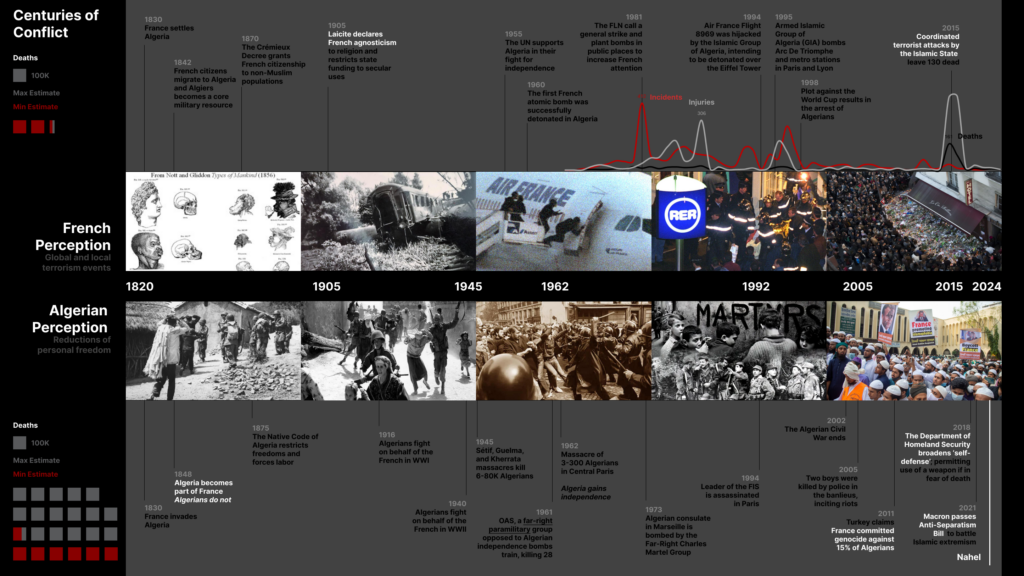
Conflation of ideals for the convenience of power | France has been a hotbed for marked terrorism and terrorism has become associated with Muslim people. In 2020, a national security bill further protected police power with Article 24 instituting a ban on filming of police officers on duty with an intention to harm them.
- Enforcement of Police Power |
- Since 2017, French law has allowed police to use their firearms in five different scenarios:
- When their life or physical safety, or the life of another individual, is put at risk;
- When a place or people under their protection come under attack;
- When they are unable to prevent someone likely to threaten their life or physical safety, or other people’s, from fleeing;
- When they are unable to stop a vehicle whose driver has ignored an order to stop and whose occupants are likely to pose a risk to their life or physical safety, or to other people’s;
- If there is reason to believe it will prevent murder or attempted murder.
- Since 2020, people found guilty of filming police officers with malicious intention could be punished by a year in prison or a fine of up to €45,000.
- Since 2017, French law has allowed police to use their firearms in five different scenarios:
- Enforcement of Secularist ideas | In response to a rise in terrorist attacks, France secularist policy was passed in 2017 to reduce Muslim freedoms in the name of laïcité—a the French republic’s political commitment to secularism—which has prohibited the French from recognizing any religion since 1905. The policy change infringed on the practice of Islam through the following provisions:
- Reductions in Freedom
- No homeschooling
- No online hate speech
- No virginity certificates with fine of €15,000
- No polygamy
- No wearing of abaya in public schools
- Increase in Executive Power
- Power to dissolve organizations becomes an administrative decision
- Power to close places of worship associated with terrorism
- Reductions in Freedom
Probe
Given this context, the key question that this project aims to answer is:
How is the conflict between the French state and disenfranchised groups experienced spatially as false ideals in the Parisian metropolis?
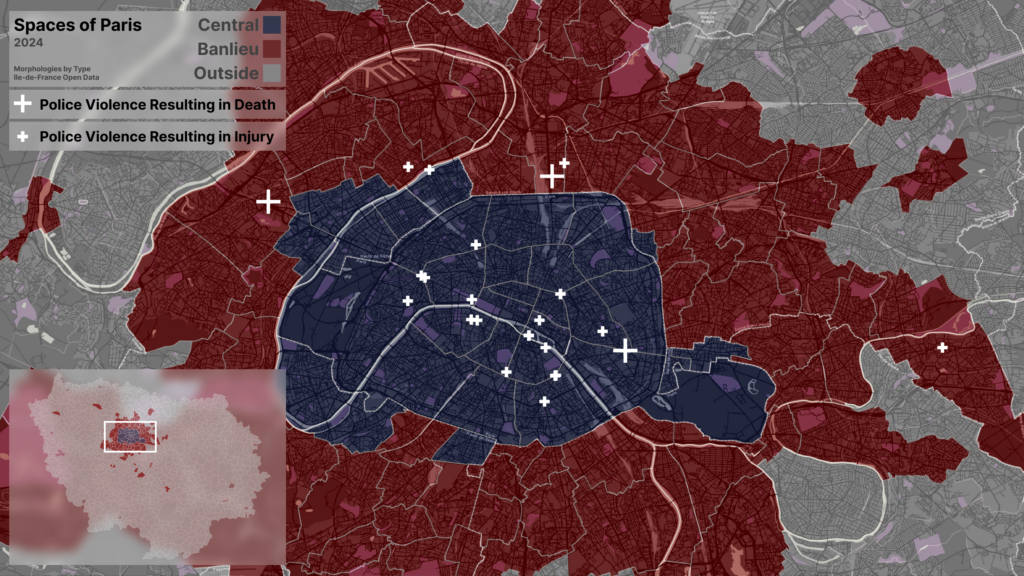
Methodology
The methodology that we employed was inspired by the theoretical framework of the studio: networked flows. Paris is a city where the public transport network is central to its experience. It connects spaces with disparate conditions of living. This difference in potentials we claim is central to the conflict experience.
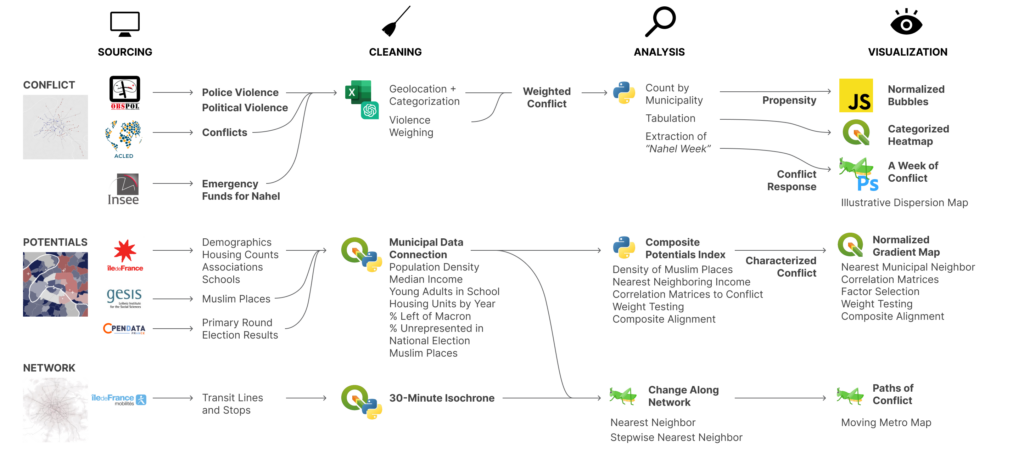
Potentials
Indexing demographics charging the field of conflict
The potentials map, mapping likelihood of violent police conflict by Ile-de-France municipality, was constructed by detangling correlated demographic statistics using a linear regression. Open data from Ile-de-France; the Insee, the French Census; the French Republic, and MAPISLAM, a database of Muslim places were collected, cleaned, and correlated. A correlation matrix and a ranking of municipalities for each statistic allowed for the isolation of predictive factors.
The composite score reveals the value of each statistic to predicting the outcome of police violence resulting death. The outcome revealed a landscape of difference which is mainly felt through sharp shifts in income, electoral power, and race. The differences are geographically stark and coherent across the different factors: Some areas such as Nanterre, Saint Denis and Nation (incidentally correlating with three fatal acts of police violence) live under significantly different conditions than other parts of the city.

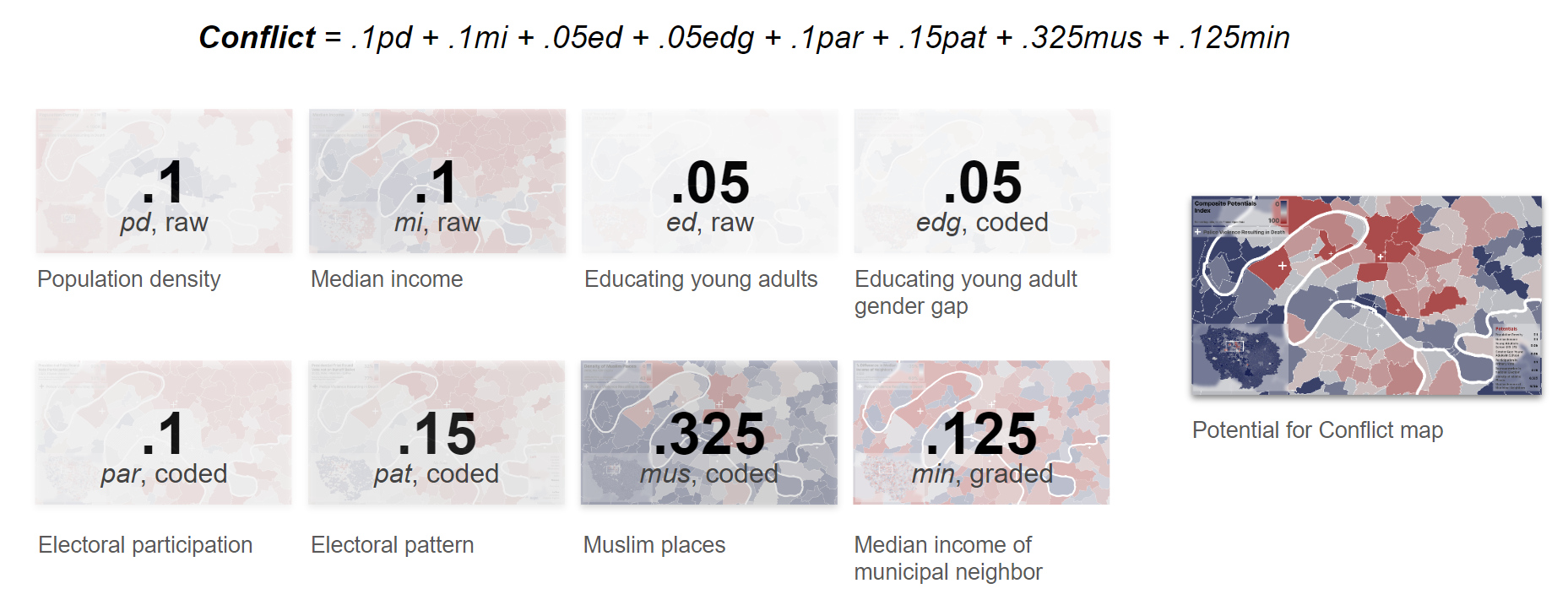
Power of Income | The median income of a place and the difference between the income of a place and its neighbors are seen as charges along lines of conflict. For each municipality the five adjacent municipalities that share the largest perimeter were selected as neighbors. To arrive at the directional difference between a municipality and its nearest neighbors, a weighted average was taken of the difference between the municipality’s median income and its neighbors.

Power of Choice | Political participation, choice, and representation by municipality were analyzed through the 2022 Presidential Primary Election results to understand the differences in perceived power, preference along the political spectrum, and ability to vote for chosen primary candidate in the national election (The French Republic). Power is low where few eligible voters vote and voters lean left as Emmanuel Macron, center on the spectrum, and Marine Le Pen, on the far right, were the only primary round candidates on the final ballot. Data was unavailable at the arrondissements level in municipal Paris, clouding the degree choice varies in the center.
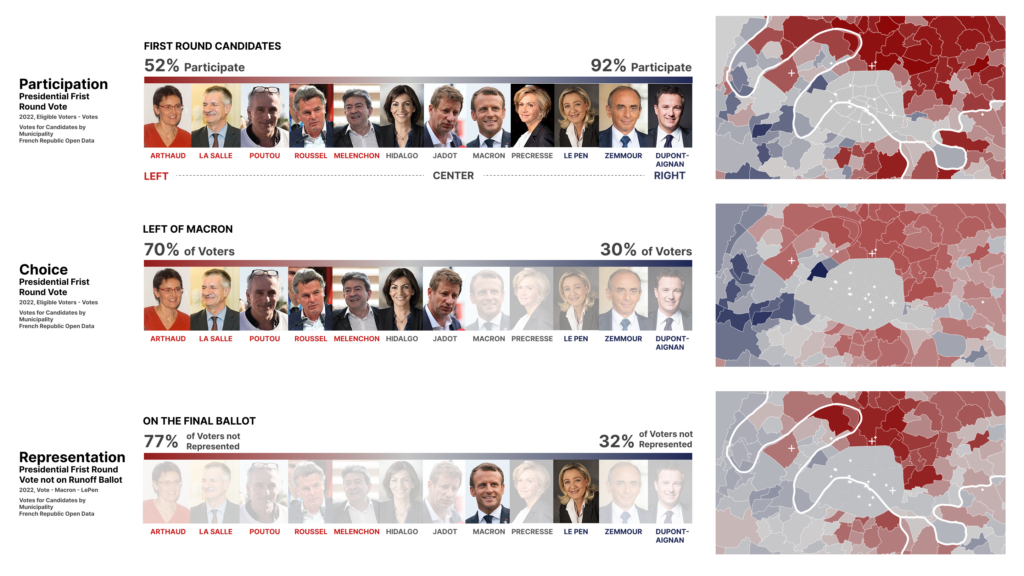
Power of Freedom | The power of freedom viewed through the ability to express religious beliefs. Since the religious affiliation and race of French citizens are not tracked, the location of Muslim places—mosques religious schools, religious libraries, and halals—are taken as proxy for the presence of populations practicing Islam. The MAPISLAM dataset of Muslim places in Urban France provides the point locations of categorized Muslim places. Presence of Muslim places is the demographic factor with the largest predictive power for police violence resulting in death.
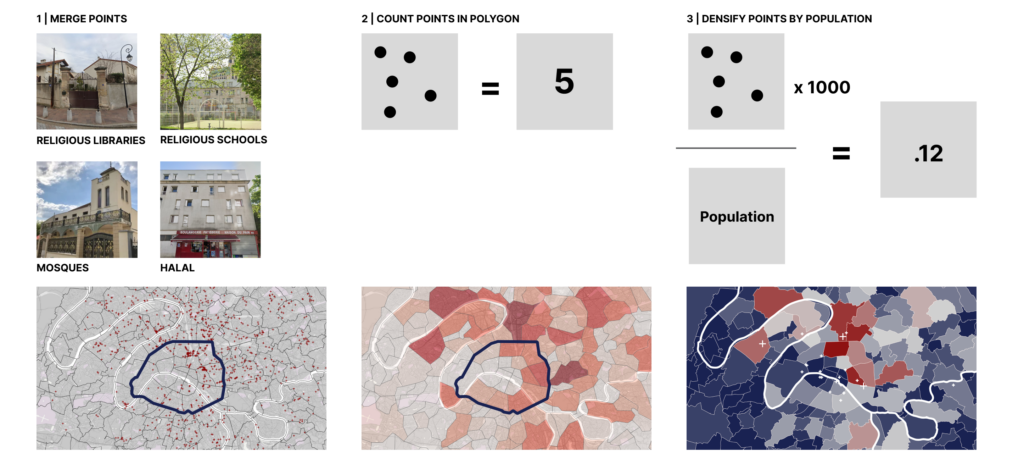
Networks
Linking the experience of difference | The next step was then to model this landscape and to demonstrate the experience of difference as one moves through it. The striking difference in infrastructural quality when moving from an area of lower power to high power is seen as the change in median income between a municipality and its neighbor along the Champs-Élysées and Line 14, the metro lines of vast income difference and frequent conflict.

Conclusion
France has a long way to go before French ideals mirror reality. Instead, the French streets are a warming hotbed for conflict, incited by police with increasing power, low-income people at risk of displacement, and specific sects of people with degraded freedom.
A sensitive approach from authorities is required to attune ideals of liberty, equality, and fraternity by improving access to quality infrastructure, freedom to practice and from violence though revision of recent policy, and rhetoric to reduce the charge of potentials in spaces of conflict.
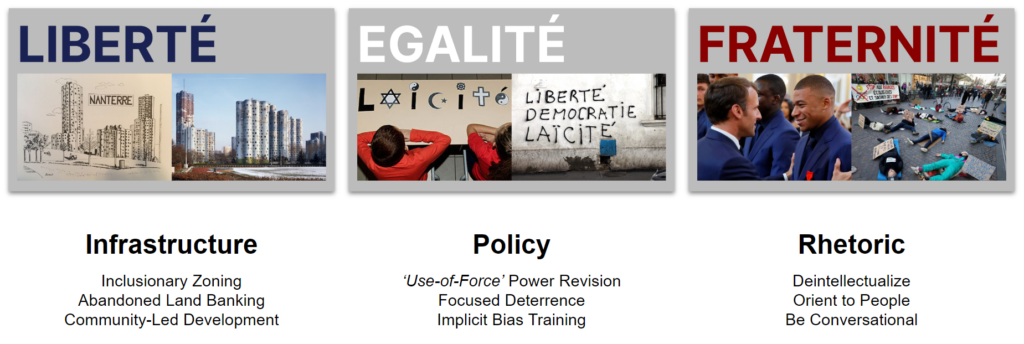
Future exploration of this and other conflicts should include historical lookbacks of migration patterns from countries with high Muslim populations, mappings of Muslim institutions, understanding of their infrastructural quality, and trail-and-error construction of a composite predictive index for conflict.
Sources
- GESIS, Drouhot, Lucas (2019): MAPISLAM: A Spatial Dataset of Muslim Institutions in Urban France. GESIS, Cologne.
- London School of Economics
- Reuters
- Al-Jazeera
- CORE
- Urban Institute
- RAND Institute
- Bloomberg CityLab
- Albertine
- New Lines Magazine
- Ile-de-France Open Data
- The French Republic
- Obs-Pol
- ACLED
- The Atlantic
- France24
- The Guardian

